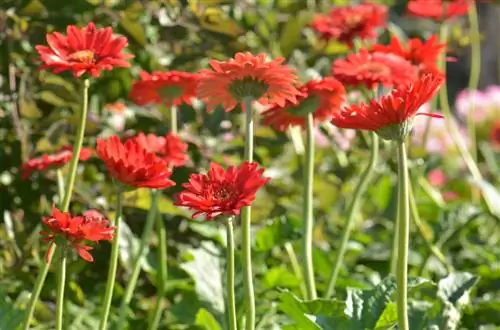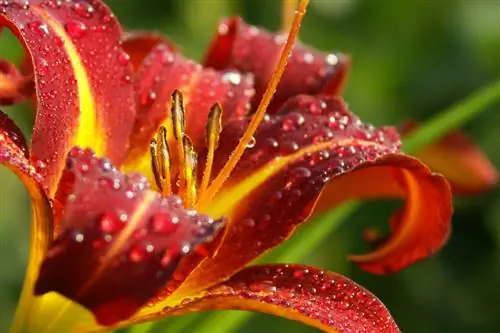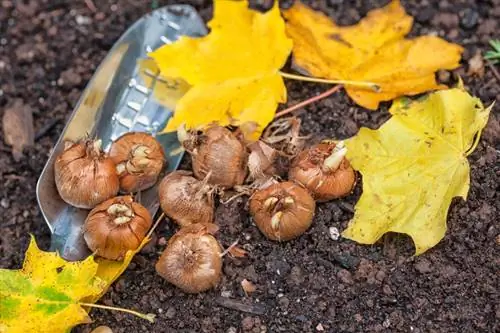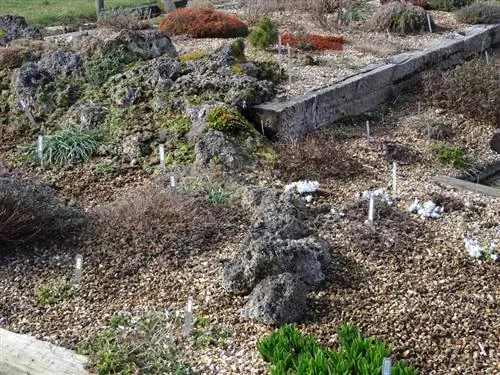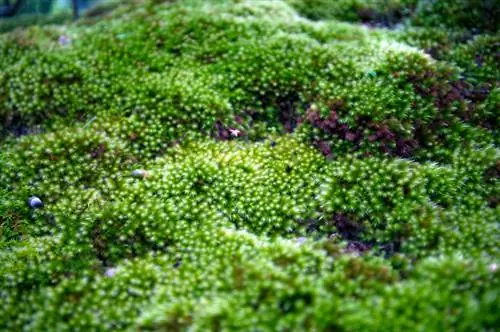- Author admin [email protected].
- Public 2023-12-25 17:45.
- Last modified 2025-01-23 11:22.
Thanks to Skimmia japonica, winter dreariness in the garden is a thing of the past. With bright red berry decorations, the plant drives away melancholy and ushers in spring with creamy white flowers. Let yourself be surprised at how easy it is to cultivate.

How do I care for Skimmia japonica properly?
Skimmia japonica is an undemanding, evergreen plant that produces bright red berries in autumn and creamy white flowers in spring. It prefers partially shaded locations, humus-rich, slightly moist soil and a regular supply of nutrients. A distance of 30-50 cm should be maintained in the bed.
Planting skimmia correctly
September is the time to plant skimmia. If you plant the picturesque flower and fruit ornamental trees in the ground after this process, the floral spectacle won't be long in coming. Before you start working in nutrient-rich, freshly moist soil in a partially shaded location, place the still potted root balls in soft water. This is how it continues:
- Dig small pits at a distance of 30-50 cm with 1.5 times the volume of the root ball
- Unpot the soaked root ball and place it in the middle of the planting hole
- Instead of the excavated soil, preferably plant with rhododendron substrate (€20.00 on Amazon) up to the bottom pair of leaves
- Water the planting site and mulch with leaves or bark mulch
If a Skimmia japonica functions as a decorative plant in a pot, the work is similar. Additionally, place some pottery shards above the water drain in the ground so that they act as drainage to counteract harmful waterlogging.
Care tips
In order to fully enjoy the flowers and fruits of a Skimmia japonica, these care factors are important:
- Water moderately with soft water after the substrate has dried
- Fertilize every 2 weeks from April to August
- Cut back and thin out a male plant after flowering if necessary
- Do not clean out female Skimmia and only shorten it in early spring
Light winter protection is recommended in the bed in the first two years. Cultivated in a bucket, precautions should be taken every year against frosty temperatures. It is important to note that the evergreen plant continues to be watered during the cold season.read more
Which location is suitable?
In order for the concentrated beauty of the Asian plant to unfold, the location should be like this:
- Sunny to semi-shady location without direct sunlight
- Ideally in the sheltered lee of tall trees
- Likes to be humid near bodies of water
read more
The correct planting distance
Skimmia create a picturesque appearance in small groups. Since the plant, as a dioecious species, cannot act as a solitary plant anyway, the question of the correct planting distance for Skimmia japonica is of particular relevance. Arrange female and male specimens at a distance of 30 to 50 cm from each other, or2 to 3 skimmia per square meter.
What soil does the plant need?
Skimmia favor nutrient-rich, humus-rich and slightly moist soil. Since the plant only tolerates a little lime, it thrives wonderfully in ericaceous or rhododendron soil. A Skimmia japonica feels extremely comfortable in the immediate vicinity of coniferous trees, as the soil here is always slightly acidic and low in lime.
When is flowering time?
Skimmia decorate the spring garden with white flowers from April to May. In female Skimmia japonica, the flower acts as an overture to the furious fruit stand with bright red berries in autumn and appears rather discreet. In contrast, the focus of a male plant is exclusively on the flowers. The splendor unfolds correspondingly lavishly, refined with an intoxicating scent of lily of the valley.
Cut skimmie correctly
In view of the leisurely growth of 5 to 15 cm per year, pruning is rarely included in the care plan. As a rule, thorough thinning immediately after flowering or in early spring is sufficient. If necessary, cut back a male flower skimmia immediately after flowering. The withered flowers of female Skimmia japonica are not removed because the longed-for fruit decorations develop from them.read more
Watering skimmie
The floral masterpiece of a Skimmia japonica is based not least on a well-balanced water balance. There should be neither drought stress nor waterlogging. Only water the plant when the surface of the soil has dried out. This is more common in the pot than in the bed. To prevent excess lime from accumulating in the substrate, we recommend using soft rainwater or decalcified tap water.
Fertilize skimmies properly
One of the main pillars in skimmia care is a balanced supply of nutrients. Only a regular supply of energy enables the ornamental tree to produce an exuberant abundance of flowers and lush fruit decorations. Fertilize the plant every 14 days from March to August with compost in the bed and liquid fertilizer in the pot.read more
Wintering
Well-established skimmia are completely hardy. Light winter protection only makes sense in the first two years in the bed and in the pot every year. How to do it right:
- From the beginning of September, water less and no longer fertilize
- Before the first frost, pile up the root disc with leaves, brushwood or bark mulch
- Place pots on wood and wrap with foil
- Ideally overwinter bright and cool, not above 15 degrees Celsius
As an evergreen plant, skimmia continue water evaporation in winter. Therefore, water on mild days when it is dry.
Skimmie in a pot
As a decorative plant in a pot, Skimmia japonica takes gardeners' hearts by storm. To ensure that the joy of flower and berry decorations lasts for a long time, we have summarized relevant cultivation factors for you:
- Keep away from the blazing sun on the balcony and windowsill
- Fertilize every 2 weeks from March/April to August
- Keep the substrate constantly moist with soft water
- Do not clean out female skimmia as the fruits grow from the flowers
Skimmia are only partially suitable as houseplants during the winter. Temperatures must not exceed 15 degrees Celsius. In addition, dry heating air has a lasting impact on the floral beauty.
Is skimmie poisonous?
As a rue family, skimmia contain alkaloids in all parts and are declared as a slightly poisonous plant. This fact implies that the red berries are only used for decoration in autumn. Intentional or unintentional consumption of the toxic fruits causes significant symptoms of poisoning. Consequently, Skimmia japonica are not suitable for the family garden, where little explorers are on expeditions and put everything in their mouths.
Yellow leaves
The visual expressiveness of a Skimmia japonica is massively impaired when the shiny green leaves turn yellow. Furthermore, this shortcoming indicates problems in cultivation. The most common causes at a glance:
- Too sunny location: settle Skimmia in partially shaded place
- Nutrient deficiency: Fertilize the plant every 2 weeks from March to September
- Waterlogging: Only water Skimmia japonica when the substrate has dried out
In addition, the plant reacts sensitively to calcareous substrate and irrigation water. Use rhododendron or ericaceous soil and water predominantly with collected rainwater or stale tap water.read more
Beautiful varieties
The following selection of beautiful varieties presents both female and male breedings. Only female Skimmia are able to decorate the winter garden with the bright red fruit clusters, known in the trade as fruit Skimmia. However, if you have an enchanting spring blossom with a wonderful scent of lily of the valley in mind, then you should choose a male Skimmia japonica, identified as a flower skimmia in the garden center's offering.
- Foremanii: Female Skimmia japonica with bright red fruits in autumn and winter; Growth height 60-100 cm
- Rubella: The male plant impresses with red buds in autumn and white flowers in May; Growth height 70-90 cm
- Veitchii: Fruit skimmie with extra large, glossy green leaves and red berries in autumn; Growth height up to 150 cm
- Fragant Cloud: Enchanting flowering skimmia with an intoxicating scent in April and May; Growth height 100-120 cm
- Magic Marlot: Small, male plant with white-pink flowers that thrives wonderfully in a pot; Growth height 40-50 cm


